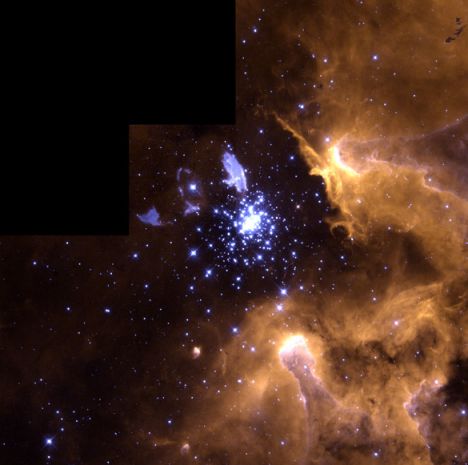Credit & Copyright: Wolfgang Brandner (JPL/IPAC),
Eva K. Grebel (U. Wash.),
You-Hua Chu (UIUC),
NASA
Explanation:
From beginning to end, different stages of a star's life appear in
this exciting Hubble Space Telescope picture of the environs
of galactic emission nebula
NGC 3603.
For the beginning, eye-catching "pillars" of glowing
hydrogen at the right signal
newborn stars emerging
from their dense, gaseous, nurseries.
Less noticeable,
dark clouds
or "Bok globules" at the top
right corner are likely part of a still earlier stage, prior to their
collapse to form stars.
At picture center lies a cluster of bright
hot blue stars whose strong
winds and ultraviolet radiation have cleared away nearby material.
Massive and young, they will soon exhaust their nuclear fuel.
Nearing the end of its life, the bright supergiant
star Sher 25 is
seen above and left of the cluster, surrounded by a glowing ring and flanked
by ejected blobs of gas.
The ring structure is reminiscent of
Supernova 1987a and Sher 25
itself may be only a few thousand years from its
own devastating finale.
But what about planets?
Check out the two
teardrop-shaped objects below the cluster
toward the bottom of the picture.
Although larger, these emission nebulae are similar to suspected
proto-planetary disks (proplyds) encompassing stars in the Orion Nebula.
1999 2000 2001 2002 2003 2004 2005 2006 2007 2008 2009 2010 2011 2012 2013 2014 2015 2016 2017 2018 2019 2020 2021 2022 2023 2024 2025 |
Yanvar' Fevral' Mart Aprel' Mai Iyun' Iyul' Avgust Sentyabr' Oktyabr' Noyabr' Dekabr' |
NASA Web Site Statements, Warnings, and Disclaimers
NASA Official: Jay Norris. Specific rights apply.
A service of: LHEA at NASA / GSFC
& Michigan Tech. U.
|
Publikacii s klyuchevymi slovami:
nebula - star formation - planet formation - supernova - Evolyuciya zvezd - zvezdoobrazovanie - zvezdy
Publikacii so slovami: nebula - star formation - planet formation - supernova - Evolyuciya zvezd - zvezdoobrazovanie - zvezdy | |
Sm. takzhe:
Vse publikacii na tu zhe temu >> | |
